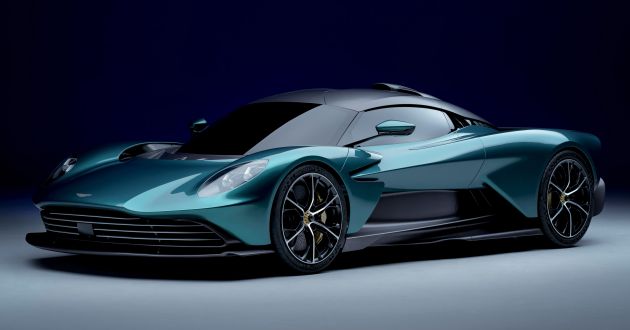In March 2019, Aston Martin introduced the AM-RB 003 concept, which previewed a new model that would later be known as the Valhalla. Fast forward to today, the British carmaker has now unveiled the production version of the Valhalla, and there are a few differences from the initial concept presented.
For starters, the “son of Valkyrie” will not be limited to a production run of 500 units, and according to Autocar, the previously suggested price tag of one million British pounds (around RM5.8 million) has been slashed to between 600,000-700,000 British pounds (around RM3.45-4.07 million).
As a result, it’s relatively more affordable and you won’t need to rush to secure an allocation for yourself, but what’s the catch here? Well, if you’re hoping for Aston Martin’s bespoke 3.0 litre hybridised V6 to power the Valhalla, you’ll be disappointed to know that the company has gone in a different direction instead.
That’s not to say that the replacement engine is lacking in terms of performance, as it is a 4.0 litre twin-turbo V8 that serves up 750 PS (740 hp) at 7,200 rpm. Aston Martin says it is a bespoke engine, but given the company’s partnership with Mercedes-Benz, this is essentially an AMG engine.
More specifically, we’re likely looking at the V8 taken from the GT Black Series, as the Valhalla’s V8 also features a flat-plane crankshaft for increased responsiveness. However, unlike the GT Black Series, the Valhalla gets an eight-speed dual-clutch transmission that was exclusively designed and built for Aston Martin by Italian supplier Graziano.
The transmission, along with a rear electronic limited-slip differential, sends the engine’s power to the rear wheels. Aston Martin didn’t just stop there, as it also decided that the Valhalla should be its first plug-in hybrid vehicle, so in comes a pair of electric motors to supplement the V8.
One of the e-motors is located on the front axle, while the other is found on the rear axle. Together, the e-motors contribute a further 204 PS (201 hp), with the total output being 950 PS (937 hp) and 1,000 Nm of torque.
As with most PHEVs, the car can run on battery power alone, which will see the front e-motor doing all the work. In EV mode, the Valhalla will hit a maximum top speed of 130 km/h and has a range of 15 km.


What’s different is that both the rear e-motor and the V8 can run on different cars in the DCT simultaneously for maximum performance. Fully unleashed, the Valhalla will complete the 0-100 km/h sprint in just 2.5 seconds and will hit 330 km/h.
As for the rest of the car’s setup, push rod suspension with inboard mounted springs and dampers can be found at the front, while the rear uses a multi-link design. The Valhalla also uses two-stage springs from Canadian supplier Multimatic, adaptive spool valve dampers, carbon-ceramic brakes (with brake-by-wire technology), staggered wheels (20-inch front and 21-inch rear) and bespoke Michelin tyres.
Design-wise, the Valhalla remains rather faithful to the original concept, retaining the forward-hinged dihedral doors, prominent roof scoop, one-piece rear wing and swooping rear deck. However, the front now features the brand’s signature vane grille located below rounder matrix LED headlamps.
The sculpted sides are also slightly toned down here, accompanied by numerous intakes and vents to promote downforce. At the rear, the large tunnels that form part of the diffuser are still present, as are the taillights, but the top-exit tailpipes (with active flaps) are now positioned closer to each other.
All the aerodynamic elements you see, including the venturi tunnels you can’t see underneath, play a part in generating downforce, with the company claiming 600 kg at 241 km/h. Aston Martin says it is targeting for a dry weight of less than 1,550 kg, and with all other aspects brought in, the company is looking to lap the Nürburgring at under six minutes and 30 seconds.
We don’t have a view of the Valhalla’s finished interior for now, but expect it to be race car-like as the concept suggested. Aston Martin says it opted for a simplified cockpit that prioritises ergonomics for the driver, but instead of a phone holder in the concept, there will be a proper infotainment system and some creature comforts like air-conditioning, a rear-view camera and driver assists.
Further development work on dynamics will be undertaken by Aston Martin as well as Sebastian Vettel, Lance Stroll and Nico Hulkenburg, with all three being drivers for the company’s works team. The Valhalla is the third model in Aston Martin’s series of mid-engine cars after the Valkyrie and Valkyrie AMR Pro, with a fourth on the way, previewed by the Vanquish Vision Concept.















The post Aston Martin Valhalla debuts in production form – 4.0L twin-turbo V8 PHEV making 950 PS and 1,000 Nm appeared first on Paul Tan's Automotive News.




0 Comments